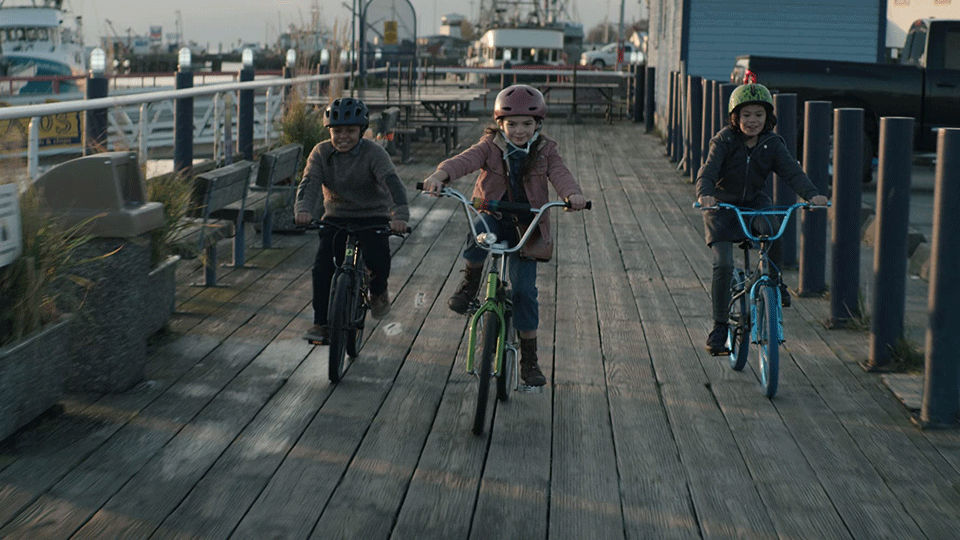
It’s the first masterful series from Apple TV+, after a horrible slip out of the gate with the clumsy, awkward The Morning Show. Home Before Dark details the efforts of a nine-year-old reporter to get to the bottom of a disappearance and supposed murder that has wracked a small town in the state of Washington. While The Morning Show glamorizes mainstream media, by supposedly reveling in its foibles, Home Before Dark is an actual critical series that exposes, though its youthful truth seeker, the inner workings of a small town ruled by aging male public officials who conceal and bury the truth.
The key to the series, which has several well-defined and extremely differentiated characters, is the intrepid reporter Hilde Lisko, based on an actual pre-teen journalist. The real-life journalist, also named Hilde, covers the crime beat, but the series improves on reality by altering this trajectory so that what the fictional Hilde focuses on is broader than crime reporting. Her interest is investigative journalism, and her heroes come from All The President’s Men.
Her single-minded pursuit of the truth gets her to the bottom of a long-buried crime which had resulted in the ostracizing of a Native American (Yakama) brother and sister. The brother, she discovers, had been falsely convicted of the disappearance of a young boy. The sheriff, the mayor and the sheriff’s son all have secrets around the disappearance which they guard jealously.

Hilde also assembles a team to help in her investigation. There are her two classmates, an Asian girl and an African-American boy, Spoon and Donny. Donny is particularly well fleshed out as a worldwise nine-year-old investigative entrepreneur. Her other allies include the independent African-American female deputy, Trip, the lone truth seeker in the sheriff’s office, as well as Hilde’s lawyer mother who comes to the aid of the jailed Native American Sam. The villains are equally well drawn: The smug sheriff who constantly covers up his initial rush to judgment, the alcoholic mayor who may have beaten his son, the missing boy Richie, and the sheriff’s son, Frank, caught up in the lies of his father which have imprisoned him as well.
What the series does is assemble a group of outsiders who challenge the (white, male) power structure in the town and succeed. It’s a Me-Too fairy tale where diversity triumphs. The enterprise is led by the stunning performance of Brooklynn Prince, its stalwart heroine.

The show tells some truths as well about what this new generation is facing. It has the structure of the John Hughes Teen Films of the 1980s, with its assembling of a Scooby-Doo gang, its focus on the romance of the adolescent older sister Izzy, and its food fight at school in the midst of which Hilde’s group is assembled. However, this is a darker time than the ’80s, so the “teens” here are nine-year-olds, that is, exposed to murder, corruption, and cover-ups much earlier than in the ’80s when neoliberalism was just starting to take hold. In these more perilous times, the confluence of greed and corruption is an essential part of what kids must confront in growing up. The darker mood is echoed and announced in the soundtrack which refrains strands from Blue Velvet, itself partially a young adult and teen film which describes a far more guilty world than the films of the early ’80s.
Home Before Dark also features generational differences in technology with its focus on the social media expertise of its pre-teen characters such that, for example, Hilde’s paper is online while her father’s was printed. The young entrepreneur Donny notes about their foes, “My intel tells me they are smart and savvy,” and Hilde must explain to her grade-school colleagues what in the world microfiche is. Here, though, unlike Netflix’s Stranger Things, the technology gap is seen as something to be overcome in their exposure of the truth, not as mere nostalgia.
The only false note in the series is the character of Hilde’s father. Her sister Izzy, in a stunning moment, accuses Hilde of “sucking the wind out of” everyone around her, as the sister, another well-drawn character, feels stifled in a family with a star reporter. In the same way, Jim Sturgess’s constant mumblecore Marlon Brando as Matt Lisko, a relocated Brooklyn slacker, is a solitary piece of ham acting that attempts to suck the wind out of what is an otherwise stunning ensemble cast. His digressions and constant illogical reversals often bring the show to a halt. Perhaps this is the problem of a group of actors, relatively less known, and a single actor, with more of a reputation (Cloud Atlas, Across the Universe), who attempts to monopolize the show and as such puts his own patriarchal imprint on it.
But this drawback does not succeed in sinking or even deterring the forward motion of the show. Hilde and her expert crew of diverse truth seekers expose and triumph over the decaying debris of a white male power structure which attempts to hang on at all costs and stands in the way of progressive change.










